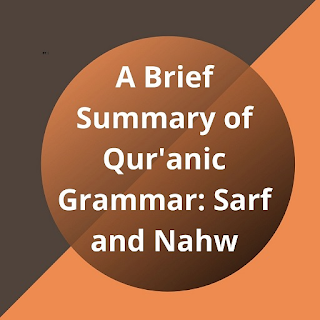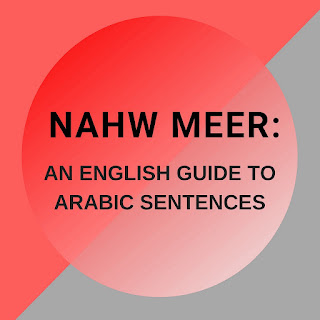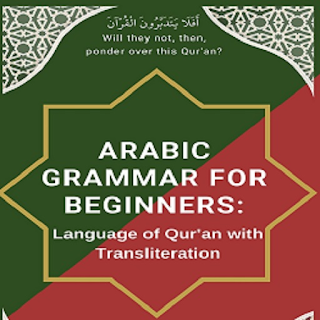Sarf and Nahw Summary: 4.1/4.2/4.3 - Nominal Sentence Rules
Nominal Sentence Rules
4.1 - Mubtada and predicate
a. both are always Nominative
b. If both mubtada and predicate are definite (مَعْرِفَة), then a pronoun called ضَمِيْر فَصَل is brought in between and is called (لَا مَحَلَّ لَهَا مِنَ الإعْرَابِ) meaning There is no position for it in flexibility and it is inactive (if it is an active element).
An example would be from Luqman ayah 30:
ذَالِكَ بِأَنَّ اللهَ هُوَ الْحَقُّ
“This because that Allah is the only truth or Haqq”.
هُوَwas introduced to create distance between الْمُبْتَدأ(اللهَ) and الْخَبْر(الْحَقُّ).
Anna (إنَّ) in this example is called sababiyyah (سبَبِيّة). Zalika (ذَالِكَ) is mubtada (الْمُبْتَدأ), Allah is noun of inna, hua is zameer fasal, alhaqqu is the predicate. Inna with its noun and predicate is a nominal sentence and majroor of bi (بِ). This jaar/majroor becomes mutallaq and then predicate for zaalika.
c. Mubtada is never a nakirah. But if it comes after a nafi, then it can be. For example:
فَلَا خَوفٌ عَليْهِمْ وَلَا هُمْ يَحْزَنُوْنَ
Here فَلَا خَوفٌ is appropriate to be called a mubtada.
d. Mahzoof (مَحْذُوْف) Omitted: Many times, to create a complete meaning, an omitted noun or a verb has to be assumed since meaning are embedded in the sentence. For example:
وَإِنْ يَمْسَسْكَ اللَّهُ بِضُرٍّ فَلَا كَاشِفَ لَهُ إِلَّا هُوَ
If Allah touches you with affliction, then there is none to remove but He (6:17)
Here, a word maujoodun (مَوْجُوْدٌ) called a مَحْذوْف (assumed) is added after لَهُ. So, (لَهُ موجودٌ) becomes shibhul jumla and then is a predicate الْخَبْر, هُوَand كاشِفَ are بَدْلand مُبْدَل مِنْه, together make the noun. and لَا is لَا نَفِيْ بِلَيْسَ (nafi similar to Laisa which is an incomplete verb). This makes it a Nominative sentence.
۞۞۞
Section 4.2 - Other Mubtada and Predicate Rules
a. A noun/pronoun before a verb is always a mubtada (مُبتَدَاء) as in أَنْتُمْ تَمْتَرُونَ. Here أَنْتُمْ is the noun (pronoun).
b. A relative clause صِلَةٌ and relative pronoun اِسْم مَوْصُوْل together can be any one of the predicates, Adjective (صِفَة), Beginning Noun (الْمُبْتَدأ) mubtada, Condition (شَرْط) or Response (جَوَاب شَرَط) and becomes non-informative sentence (جُمْلَة إنْشَائِيَة) Jumla Insha’iah.
c. If a verb comes after an indefinite noun, it is usually in the form of a siffat (adjective)
۞۞۞
Section 4.3 - Other General Notes for Nouns
1. The Source noun is also used in the exaggerative form (مبالغةٌ) as a verb with a proper scale.
2. Usually, if 2nd or 3rd alphabet in a root of the verb is from Huroof Halaqi (حُرُوْف حَلْقِي), then the form is usually from (فَ).
3. Actor/subject noun اِسْم فَاعِل or Object noun اِسْم مَفْعُول when used with alif laam, then it is jama’ Kathrah, without it it is jama’ Qillah.
4. Adjective (صِفَة) is also called (النَّعْت) and points to (مَنْعُوْت) also called mausoof.
5. Feminine plural has long taa (ت) at the end and not round taa (ة).
6. Alladhi is a mausool and it is better to make it a mubtada after combining it with sila.
7. Ayyu/ayya are ism Zameer: For example, ayyukum أيُّكُمْ, ayyu is a noun of istefham and is mudaaf/ and kum is mudaaf ilaihi. This means which one of you?
8. Tamyeez/mumayyaz: For example, أيُّكُمْ أحسَنُ عمَلًا. Here Ahsanu is predicate begging the question “best in what”. Amala is tamyeez/clarification and mumayyaz is ahsanu.
9. The source (مَصْدَر) cannot be dual or plural for obvious reason.
10. When a state حال and stated ذُوْالْحَال are considered, then, make note that ذُوْالْحَال is never an indefinite noun نَكِرَةٌ
۞۞۞





Comments